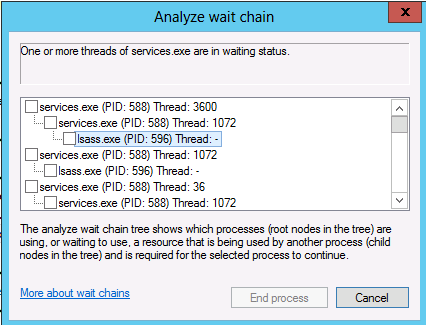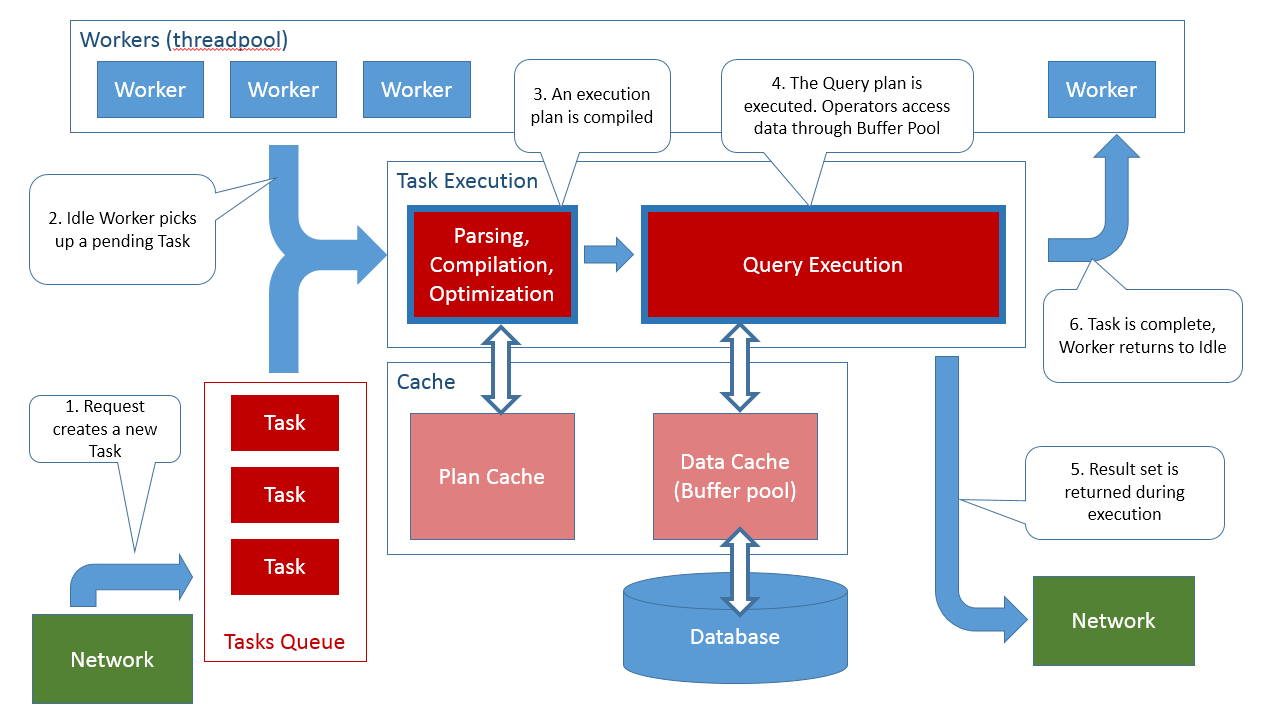Identifying SqlConnection objects in a dump
September 22nd, 2017I recently had to troubleshoot an ADO.Net connection pool exhaust issue. This problem may indicate a connection leak, but it can also be caused by an undersized connection pool. For analysis I used Windbg. For a quick introduction on how to use Windbg with managed code, see here. Once the problem was reproduced, I took a process dump, copied the dump to my laptop and started digging.
I started by finding a SqlConnection object in the dump. !DumpHeap can be used to dump all objects in all heaps, which is rather verbose. By using the -type filter we can restrict the output to only the objects with type name that contain a given string, and I also restricted to display only the aggregated statistics (-stat) rather than each individual entry:
0:081> !DumpHeap -type System.Data.SqlClient.SqlConnection -stat
Statistics:
MT Count TotalSize Class Name
00007fff50d4dd90 1 56 System.Data.SqlClient.SqlConnectionPoolGroupProviderInfo
00007fff50d4ed90 1 64 System.Data.SqlClient.SqlConnectionFactory
00007fff50b99cd0 1 80 System.Collections.Generic.Dictionary`2[[System.String, mscorlib],[System.Data.SqlClient.SqlConnectionStringBuilder+Keywords, System.Data]]
00007fff50d4e730 1 216 System.Data.SqlClient.SqlConnectionString
00007fff51348288 1 1440 System.Collections.Generic.Dictionary`2+Entry[[System.String, mscorlib],[System.Data.SqlClient.SqlConnectionStringBuilder+Keywords, System.Data]][]
00007fff5135b5d0 51 1632 System.Data.SqlClient.SqlConnection+<>c__DisplayClass152_0`1[[System.Int32, mscorlib]]
00007fff091c6940 133 4256 System.Data.SqlClient.SqlConnection+<>c__DisplayClass152_0`1[[System.Data.SqlClient.SqlDataReader, System.Data]]
00007fff50d4dd20 100 4800 System.Data.SqlClient.SqlConnectionTimeoutErrorInternal
00007fff50d4cca0 133 6384 System.Data.SqlClient.SqlConnectionPoolKey
00007fff50d507d8 100 9600 System.Data.SqlClient.SqlConnectionTimeoutPhaseDuration[]
00007fff51358b10 377 12064 System.Data.SqlClient.SqlConnection+<>c__DisplayClass114_0
00007fff50d4e838 700 16800 System.Data.SqlClient.SqlConnectionTimeoutPhaseDuration
00007fff50d49ee8 414 89424 System.Data.SqlClient.SqlConnection
Total 2013 objects
From this command I am interested in only one thing, the method table address for the actual System.Data.SqlClient.SqlConnection type. With this I can restrict the !DumpHeap output to only this type objects, using the -mt argument. Notice that there are 414 SqlConnection instances in the dump, although we have a default connection pool size of 100. Lets see them:
0:081> !DumpHeap -mt 00007fff50d49ee8
Address MT Size
000000de8bc9e270 00007fff50d49ee8 216
000000de8bcf3890 00007fff50d49ee8 216
...
000000e20e475910 00007fff50d49ee8 216
000000e20e4dbe18 00007fff50d49ee8 216
000000e20e5fb6f0 00007fff50d49ee8 216
If you enabled the DML preference then the output contains hot links to dumping each object with a simple click. This is just a shortcut and you can see the actual Windbg command run by the shortcut click. Lets dump the first object:
0:081> !DumpObj /d 000000de8bc9e270
Name: System.Data.SqlClient.SqlConnection
MethodTable: 00007fff50d49ee8
EEClass: 00007fff50b9ed10
Size: 216(0xd8) bytes
File: C:\Windows\Microsoft.Net\assembly\GAC_64\System.Data\v4.0_4.0.0.0__b77a5c561934e089\System.Data.dll
Fields:
MT Field Offset Type VT Attr Value Name
00007fff6069e068 4000577 8 System.Object 0 instance 0000000000000000 __identity
00007fff5f68daa8 4002882 10 ...ponentModel.ISite 0 instance 0000000000000000 site
00007fff5f68f3c0 4002883 18 ....EventHandlerList 0 instance 0000000000000000 events
...
00007fff50d4e968 4000efc 98 ...ConnectionOptions 0 instance 0000000000000000 _userConnectionOptions
00007fff50d4e5d0 4000efd a0 ...nnectionPoolGroup 0 instance 0000000000000000 _poolGroup
00007fff50d4c080 4000efe a8 ...onnectionInternal 0 instance 000000e10b4f8418 _innerConnection
00007fff606a03d0 4000eff b4 System.Int32 1 instance 5 _closeCount
00007fff606a03d0 4000f01 b8 System.Int32 1 instance 368526 ObjectID
...
Those used to native debugging and the eternal chase after symbol files will appreciate the fact that managed data types are self describing even on retail. I removed some clutter, the information I’m after is the _innerConnection. The SqlConnection is just a wrapper. Lets look at it:
0:081> !DumpObj /d 000000e10b4f8418
Name: System.Data.ProviderBase.DbConnectionClosedPreviouslyOpened
MethodTable: 00007fff50d32a18
EEClass: 00007fff50bc7ca0
Size: 96(0x60) bytes
File: C:\Windows\Microsoft.Net\assembly\GAC_64\System.Data\v4.0_4.0.0.0__b77a5c561934e089\System.Data.dll
Fields:
MT Field Offset Type VT Attr Value Name
00007fff606a03d0 4001a5d 38 System.Int32 1 instance 6 _objectID
...
00007fff45d81858 4001a6d 30 ...tions.Transaction 0 instance 0000000000000000 _enlistedTransactionOriginal
OK, so this inner connection is of the type DbConnectionClosedPreviouslyOpened, and I can make an educated guess that this is not relevant for my investigation. Lets look instead at the last SqlConnection object from my list of 414 instances, and its _innerConnection:
0:08>> !DumpObj 000000e20e5fb6f0
Name: System.Data.SqlClient.SqlConnection
MethodTable: 00007fff50d49ee8
EEClass: 00007fff50b9ed10
Size: 216(0xd8) bytes
File: C:\Windows\Microsoft.Net\assembly\GAC_64\System.Data\v4.0_4.0.0.0__b77a5c561934e089\System.Data.dll
Fields:
MT Field Offset Type VT Attr Value Name
00007fff6069e068 4000577 8 System.Object 0 instance 0000000000000000 __identity
...
00007fff50d4e5d0 4000efd a0 ...nnectionPoolGroup 0 instance 000000e08b7e0170 _poolGroup
00007fff50d4c080 4000efe a8 ...onnectionInternal 0 instance 000000df8c001ab0 _innerConnection
00007fff606a03d0 4000eff b4 System.Int32 1 instance 1 _closeCount
...
0:081> !DumpObj /d 000000df8c001ab0
Name: System.Data.SqlClient.SqlInternalConnectionTds
MethodTable: 00007fff50d4c528
EEClass: 00007fff50b9f1b0
Size: 400(0x190) bytes
File: C:\Windows\Microsoft.Net\assembly\GAC_64\System.Data\v4.0_4.0.0.0__b77a5c561934e089\System.Data.dll
Fields:
MT Field Offset Type VT Attr Value Name
00007fff606a03d0 4001a5d 38 System.Int32 1 instance 95 _objectID
00007fff6068d6f8 4001a60 44 System.Boolean 1 instance 0 _allowSetConnectionString
...
00007fff6069da88 400109d 130 System.String 0 instance 0000000000000000 _routingDestination
00007fff60699ca0 4001089 9b8 System.TimeSpan 1 shared static _dbAuthenticationContext
This time the inner connection is of type System.Data.SqlClient.SqlInternalConnectionTds, which is more interesting. Before you object that how are you going to find the SqlConnection objects that have inner connection of type SqlInternalConnectionTds, short of searching through all instances, let me say that you don’t have to. All I wanted so far was to do an introduction to the SqlInternalConnectionTds class, which is the one we’re really interested in. I could have started directly with it and ask you to take my word for it,
but I wanted you to see how I came to find this class. So lets look at all the instances of this class, using !DumpHeap -mt ... with this class method table address:
0:081> !DumpHeap -mt 00007fff50d4c528
Address MT Size
000000de8bd10908 00007fff50d4c528 400
000000de8bd175c8 00007fff50d4c528 400
000000de8bd2a200 00007fff50d4c528 400
000000de8bd32a80 00007fff50d4c528 400
...
000000e20c2d20a0 00007fff50d4c528 400
000000e20c2f89a0 00007fff50d4c528 400
Statistics:
MT Count TotalSize Class Name
00007fff50d4c528 100 40000 System.Data.SqlClient.SqlInternalConnectionTds
There are exactly 100 instances in memory, so this really is the class we’re after. It represents an open SqlConnection. So we have a way of finding all active, open SQL connections in memory. What can we do with this information? The SqlInternalConnectionTds type has the _parser field which is an TdsParser instance, and this type has the _physicalStateObj field which is a TdsParserStateObject instance, and this type has the _outBuff field of type Byte[] and I will make an educated guess that this is the last packet sent to the SQL server on this connection:
0:117> !DumpObj /d 000000de8bd10908
Name: System.Data.SqlClient.SqlInternalConnectionTds
MethodTable: 00007fff50d4c528
EEClass: 00007fff50b9f1b0
Size: 400(0x190) bytes
File: C:\Windows\Microsoft.Net\assembly\GAC_64\System.Data\v4.0_4.0.0.0__b77a5c561934e089\System.Data.dll
Fields:
MT Field Offset Type VT Attr Value Name
00007fff606a03d0 4001a5d 38 System.Int32 1 instance 171 _objectID
...
00007fff50d4dd90 4001076 90 ...GroupProviderInfo 0 instance 000000e08b7e0808 _poolGroupProviderInfo
00007fff50d4d580 4001077 98 ...lClient.TdsParser 0 instance 000000de8bd115b0 _parser
...
00007fff60699b20 400109c 178 System.Guid 1 instance 000000de8bd10a80 _originalClientConnectionId
00007fff6069da88 400109d 130 System.String 0 instance 0000000000000000 _routingDestination
00007fff60699ca0 4001089 9b8 System.TimeSpan 1 shared static _dbAuthenticationContextLockedRefreshTimeSpan
...
0:117> !DumpObj /d 000000de8bd115b0
Name: System.Data.SqlClient.TdsParser
MethodTable: 00007fff50d4d580
EEClass: 00007fff50b9f470
Size: 160(0xa0) bytes
File: C:\Windows\Microsoft.Net\assembly\GAC_64\System.Data\v4.0_4.0.0.0__b77a5c561934e089\System.Data.dll
Fields:
MT Field Offset Type VT Attr Value Name
00007fff606a03d0 4001336 70 System.Int32 1 instance 166 _objectID
00007fff50d4c790 4001338 8 ...ParserStateObject 0 instance 000000de8bd11650 _physicalStateObj
00007fff50d4c790 4001339 10 ...ParserStateObject 0 instance 0000000000000000 _pMarsPhysicalConObj
...
00007fff606a03d0 4001335 8e0 System.Int32 1 shared static _objectTypeCount
...
0:117> !DumpObj /d 000000de8bd11650
Name: System.Data.SqlClient.TdsParserStateObject
MethodTable: 00007fff50d4c790
EEClass: 00007fff50bd7608
Size: 472(0x1d8) bytes
File: C:\Windows\Microsoft.Net\assembly\GAC_64\System.Data\v4.0_4.0.0.0__b77a5c561934e089\System.Data.dll
Fields:
MT Field Offset Type VT Attr Value Name
00007fff606a03d0 400142f 150 System.Int32 1 instance 166 _objectID
00007fff50d4d580 4001430 8 ...lClient.TdsParser 0 instance 000000de8bd115b0 _parser
00007fff50d4ebf0 4001431 10 ...lClient.SNIHandle 0 instance 000000de8bd11f20 _sessionHandle
00007fff60699a20 4001432 18 System.WeakReference 0 instance 000000de8bd11828 _owner
00007fff50d41dc0 4001433 20 ...eader+SharedState 0 instance 0000000000000000 _readerState
00007fff606a03d0 4001434 154 System.Int32 1 instance 0 _activateCount
00007fff606a03d0 4001435 158 System.Int32 1 instance 8 _inputHeaderLen
00007fff606a03d0 4001436 15c System.Int32 1 instance 8 _outputHeaderLen
00007fff606a27a8 4001437 28 System.Byte[] 0 instance 000000de8bd140c8 _outBuff
00007fff606a03d0 4001438 160 System.Int32 1 instance 8 _outBytesUsed
00007fff606a27a8 4001439 30 System.Byte[] 0 instance 000000de8bd12170 _inBuff
00007fff606a03d0 400143a 164 System.Int32 1 instance 41 _inBytesUsed
00007fff606a03d0 400143b 168 System.Int32 1 instance 41 _inBytesRead
...
0:117> !DumpObj /d 000000de8bd140c8
Name: System.Byte[]
MethodTable: 00007fff606a27a8
EEClass: 00007fff600b2348
Size: 8024(0x1f58) bytes
Array: Rank 1, Number of elements 8000, Type Byte (Print Array)
Content: ...".............._...E......................4..I.N.S.E.R.T. .[.d.b.o.]...[
Fields:
So it looks like we did found the last command sent on this connection to the SQL Server, but lets dig a bit deeper. Lets dump the Byte[] memory:
0:117> db 000000de8bd140c8
000000de`8bd140c8 a8 27 6a 60 ff 7f 00 00-40 1f 00 00 00 00 00 00 .'j`....@.......
000000de`8bd140d8 0e 11 00 22 00 00 01 00-16 00 00 00 12 00 00 00 ..."............
000000de`8bd140e8 02 00 5f 0a 00 00 45 00-00 00 01 00 00 00 07 00 .._...E.........
000000de`8bd140f8 00 00 02 00 00 00 e7 8c-04 09 04 d0 00 34 8c 04 .............4..
000000de`8bd14108 49 00 4e 00 53 00 45 00-52 00 54 00 20 00 5b 00 I.N.S.E.R.T. .[.
The first 16 bytes are for the Byte[] internal fields, and the actual array starts at 000000de`8bd140d8 (ie. the second line). To understand this packet, we need to understand the TDS protocol. Luckily the protocol is well documented at [MS-TDS]: Tabular Data Stream Protocol. Every packet starts with a packet header and the first byte is the packet type.
In our case the packet type is 0e, which is described in the previous link as a Transaction manager request. So the last operation done with this connection was a request to enlist in a distributed transaction. This behavior is typical of SqlConnection enlisting themselves in lightweight DTC because of a TransactionScope.
With all the knowledge we have so far we can use Windbg script to dump all the live connections and information about the last packet they sent to the server:
I reckon Windbg scripts are a bit arcane in syntax. poi is used to read a pointer value from an address. by reads a single low-order byte from an address. And the magic values like 98, 8 and 28 are the offsets of the relevant fields in the object instance:
- _parser at offset 98:
00007fff50d4d580 4001077 98 ...lClient.TdsParser 0 instance 000000de8bd115b0 _parser - _physicalStateObj at offset 8:
0007fff50d4c790 4001338 8 ...ParserStateObject 0 instance 000000de8bd11650 _physicalStateObj - _outBuff at offset 28:
00007fff606a27a8 4001437 28 System.Byte[] 0 instance 000000de8bd140c8 _outBuff
The script uses .foreach(obj {!DumpHeap ... -short}) to iterate through each instance of type SqlInternalConnectionTds in memory, and then for each instance it outputs Debug Markup Language (DML) links to output, in a tabular form, the SqlInternalConnectionTds instance, the _parser, the _physicalStateObj and the _outBuff. It then prints the last sent packet type:
- BTC is a SQL Batch
- RCP is a SQL procedure call (this includes any SqlCommand batch that has parameters)
- BLK is a BULK INSERT operation
- ATN is an attention (a request to cancel an executing command)
- XML is a request to enlist in a DTC
For RPC and Batch requests the script also dumps out the actual SQL command in the request. Note that this is the last packet sent, and if the SQL text was bigger than one packet then the last packet will contain only the ending of the actual command sent. Here is the output from my actual dump I was analyzing:
0:117> $$><c:\temp\dump_all_out_buffs.txt
1 000000de8bd10908 000000de8bd115b0 000000de8bd11650 000000de8bd140c8 XMR
2 000000de8bd175c8 000000de8bd18258 000000de8bd182f8 000000df0bc17180 XMR
3 000000de8bd2a200 000000de8bd2ae90 000000de8bd2af30 000000de8bd2d9a8 XMR
4 000000de8bd32a80 000000de8bd33710 000000de8bd337b0 000000de8bd4e5f8 XMR
5 000000de8bdba120 000000de8bdc1410 000000de8bdc14b0 000000de8bdc3f50 XMR
6 000000de8be0cbb8 000000de8be0d848 000000de8be0d8e8 000000de8be10360 RPC Time], [Var_24].[LastModifierUserId] AS [LastModifierUserId], [Var_24].[CreationTime] AS [CreationTime], [Var_24]...
...
15 000000de8c17ee78 000000de8c19e818 000000de8c19e8b8 000000de8c1a1670 XMR
16 000000de8c18ddf8 000000de8c18ea88 000000de8c274270 000000de8c27e908 RPC SELECT [Extent2].[Name] AS [Name] FROM (SELECT [Var_20].[UserId] AS [UserId], [Var_20].[RoleId]...
...
90 000000e20be179b8 000000e20be18648 000000e20be186e8 000000e00baecb50 RPC UPDATE [dbo].[Sessions] SET ...
91 000000e20be97138 000000e20be97dc8 000000e20be97e68 000000e20bb526f8 RPC UPDATE [dbo].[Sessions] SET ...
...
99 000000e20c2d20a0 000000e20c2d2d48 000000e20c2d2de8 000000e20c2ed5b8 XMR
100 000000e20c2f89a0 000000e20c2fe4c0 000000e20c2fe560 000000e20c302620 XMR
You can see all 100 connections in the connection pool, what was the last packet type sent to the server by each connection, and for the applicable cases, the last SQL command executed on that connection.
As an alternative to the cumbersome Windbg script syntax you can try DbgScript, which allows you to use python, ruby, LUA or other scripting languages to control Windbg.

